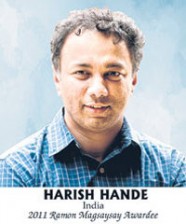Indian puts solar power technology in hands of poor
“Do not look at the poor as the bottom of the pyramid market from where you can extract money. How do you help them? How do you help them create assets?”
These questions had nagged Harish Hande, one of this year’s recipients of the Ramon Magsaysay Awards, since completing energy engineering studies in the United States.
In 1995, Hande established a company in his Bangalore hometown in India and started producing solar PV lighting systems, water heating systems and cooking stoves to meet the needs of the rural poor.
In the process, the 44-year-old engineer attacked a persistent myth that the poor could not afford the best technology, nor could they maintain and use it productively.
This myth has stood in the way of spreading solar technology and its benefits—cost-efficiency, clean energy, mitigation of climate change and improvements in the quality of life—among the poor in India, where nearly half of all households do not have electricity.
Article continues after this advertisementTrustees overseeing the Ramon Magsaysay Awards—Asia’s version of the Nobel Prize and named after a Philippine president who died in a plane crash—cited Hande’s “passionate and pragmatic efforts to put solar power technology in the hands of the poor, through a social enterprise that brings customized, affordable and sustainable electricity to India’s vast rural populace, encouraging the poor to become asset creators.”
Article continues after this advertisementIn an interview with the Inquirer on Friday, Hande said the less fortunate should not be looked down as mere consumers. They should be empowered, he said, and treated as partners. “I have to contribute to that growth.”
It was this extraordinary conviction that pushed the engineer to look for a concept that would allow him to put his belief into practice.
While a masteral student at the University of Massachusetts in 1991, Hande visited the Dominican Republic, where he met Richard Hansen, an American engineer who was then assisting households in small villages establish solar-powered lighting.
Long-term outlook
“I thought, this was exactly what Asia, India, needs,” he said. “But I didn’t know how to do it in a way that Indian villagers would actually adapt it.”
Fate appeared to be on his side.
Back in the United States, Hande met Neville Williams, a former anti-Vietnam war activist who founded Solar Electric Light Fund, a nongovernment organization that aims to promote solar energy in developing countries.
Having just received $40,000 from the Rockefeller Brothers Fund to install solar lighting in rural Indian houses, Williams asked Hande, then a doctoral student at the University of Massachusetts, to run the project.
“But I said, I don’t know how to do that. Because if you do a project, you take photographs, show it to the fund provider and that’s it. Next, what happens to the people? Let’s look at the long term. Let’s look at a company. Let’s look at the servicing of the lights in the long run,” Hande said.
The Indian went back home to find the answers. For more than two years, he traveled to villages in Karnataka state in Southern India, living like the villagers, and trying to convince them that solar lighting worked.
Collective solution
His decision to immerse himself with the poor was brought about mainly by his philosophy.
“If I have to ask a doorman a question about how life is, he has to feel that I am another doorman. Otherwise, he will say ‘yes, sir’… he will not answer me with (his) point of view… How do you cut through the education class, the hierarchy, the caste system? Let people feel that it’s their solution. They should not feel that it’s my solution,” Hande said.
Living off personal savings that amounted to some 1,000 rupees, Hande remembered having to stay in the houses of friends and relatives, at one point working as a laborer at a bus station.
“What I did and what I do is addicting in many ways… You just push, push and push,” he said.
The breakthrough came in 1993, when Hande met Arvind Rai, a farmer. Rai was unconvinced the technology would work, but his 75-year-old mother was. Hande recalled installing solar lights when the farmer was not home.
A year later, the engineer did the same to Father Thomas Myldoor’s church at Pavur, a village in Karnataka. This, he said, eventually created an awareness among the poor who attended Mass every Sunday.
“Father always jokes that he is the marketing man,” he said.
Inspiring youngsters
In 1995, Solar Electric Light Company (Selco) was finally established in Bangalore. There were still financial barriers to be hurdled. He recalled visiting rural banks at numerous times, every time bringing in poor people using his products.
Hande argued that the poor were better off with solar energy in the long run, calling this an investment in social infrastructure. Two rural banks—Bangladesh Grameen and Syndicate—finally committed funds to finance not him but the end users.
“I can provide lighting, the banks need to finance it. And consumers need to pay the banks,” he said.
This way, he said, Selco can concentrate on its mission of helping the poor, building social capital, instead of financial profit.
Despite the company being a for-profit business, poverty reduction remained central to its goal.
The social enterprise has managed to install solar lights in 120,000 households, reaching more than half a million people in India. The number, Hande said, keeps growing.
But far more important, he said, is the awareness his company has created that coordination between rural and urban people was critical for the nation’s progress.
“We have been able to inspire other youngsters to give up their cushy jobs in the cities and look at India’s actual issues,” he said with a smile. “That, I think is where we really have managed to make a difference.”
